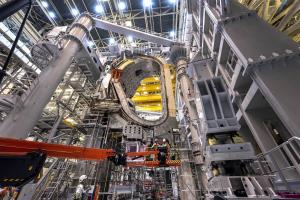A time of change and challenge
Summer is for all kinds of reading—thrillers and romances, historical novels, poetry or political essays. In the fusion world, it can also be a time for catching up on what has occurred at ITER since Newsline's last summer recess.
The past twelve months were a time of change and challenge. In September 2022, the ITER Council appointed a new Director-General, Pietro Barabaschi, who took up his functions on 17 October. In an interview with Newsline, he clearly stated the course he intended to take, expressing the need to "reorganize," regretting the lack of a "strong common culture" within the project, and anticipating the issues ITER was soon to face. "In a first-of-a-kind project such as ITER, issues, challenges, setbacks and errors are to be expected."
And issues there were. Two and a half years into ITER's machine assembly phase, dimensional non-conformities were discovered on three vacuum vessel sectors—one of them already assembled into a "sector module" and installed in the assembly pit. Considering the first-of-a-kind nature of these massive components, as tall as a five-storey building and heavier than a fully loaded Airbus A380, the non-conformities would complicate the automated welding that was to take place in situ, inside the Tokamak pit.
The subsequent discovery of instances of "stress corrosion cracking" in the cooling pipes of the thermal shield—also part of every vacuum vessel sub-assembly—raised a crucial question: were the instances a one-off problem, limited to the elements examined, or could they represent a more systemic problem affecting all thermal shield panels?
ITER opted for the no-risk option and, having identified the root cause of the cracks, decided to remove and replace all the piping in all thermal shield elements, including the ones already in place as part of pre-assembled modules."When you find three instances of cracks, it is a red alarm because there could be hundreds of locations where cracks could develop," explained Director-General Barabaschi in this January 2023 article. As a module's thermal shield panels are sandwiched between the vacuum vessel sector and the pair of toroidal field coils that close upon it, completely module disassembly was required.
For sector module #6, already in the Tokamak pit, a complex and delicate "reverse lift" operation was required. This was performed in early July; disassembly activities have already started and will proceed for several months. The repair strategy for both types of defects has been finalized and contracts have been awarded. How dismantlement and repair will impact the project's schedule and cost is still being evaluated.
Industrial issues were not, however, the only news of the past year. Component fabrication and deliveries continued at a steady pace. In the European poloidal field coil winding facility on site, one of the largest ring-shaped coils (24 metres in diameter) was finalized (PF4) and another is ready to undergo final cold testing (PF3). Japan and Europe each delivered one toroidal field coil in January and February (and two others are travelling), while the Russian-made poloidal field coil PF1 safely reached the ITER site. Whether installed, stored or nearing finalization, all ring-shaped magnets are now "home" at ITER.
In the wake of Pietro Barabaschi's nomination as ITER Director-General, familiar figures from the worldwide fusion community were appointed to senior management positions: Yutaka Kamada from Japan as Deputy Director General (Science and Technology) in March and Luo Delong from China as Deputy Director-General (Corporate) in April. Another familiar figure, Eisuke Tada, retired after having devoted almost two decades to the project and even longer to international cooperation in fusion.
One of the ''Original Six'' who staffed the ITER Joint Work Site in 2006, Eisuke Tada was appointed Deputy Director-General in 2015 and assumed the duty of interim Director-General following Bernard Bigot's passing in 2022.
These momentous 12 months at ITER were also a time of profound change in the fusion landscape globally. For decades, the quest for fusion energy had been the exclusive reserve of publically or academically funded projects. Now, things are changing. Startups are popping all over the world, attracting massive funding (USD 2.8 billion just for the year 2022) and challenging the commonly accepted timeline for bringing fusion energy to the grid. In this context, one Newsline article raised a crucial question: "What is the value of ITER as a scientific instrument?"
The answer, by ITER top scientists Tim Luce and Alberto Loarte, makes a worthwhile conclusion to the list of our recommended summer reading.



